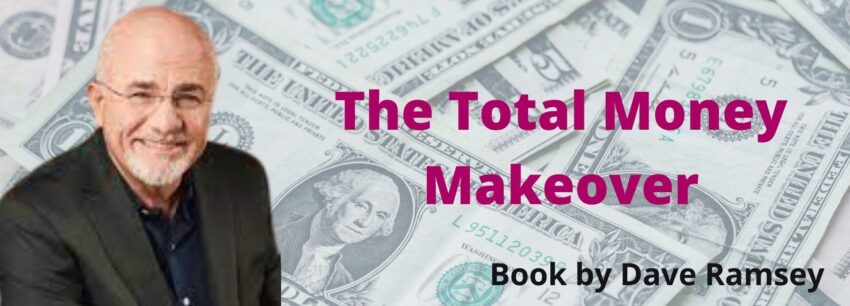Every year, take a little time to educate yourself on personal finance.
Dave Ramsey
Personal finance is 80% behavior and only 20% head knowledge.
You must gain control over your money or the lack of it will forever control you.
The Total Money Makeover by Dave Ramsey provides a step-by-step plan for individuals and families to get out of debt, build wealth, and achieve financial freedom. Here are some of the best ideas from the book:
- Start with a written budget: Write down your income and expenses, and create a plan for every dollar. This will help you see where your money is going and make better financial decisions.
Here are the steps to creating a budget:- Start by tracking your income and expenses: For one month, track every dollar you spend and every dollar you earn. You can use a budgeting app, spreadsheet, or pen and paper to track your expenses.
- Categorize your expenses: Divide your expenses into categories such as housing, transportation, food, entertainment, etc.
- Determine your monthly income: Calculate your total monthly income including your salary, any side hustles, and other sources of income.
- Assign each expense a category: Categorize each expense based on the categories you created in step 2. Determine how much you are spending in each category: Add up your expenses for each category to determine how much you are spending.
- Make adjustments: Compare your expenses to your income. If you are spending more than you earn, look for areas where you can cut back. Consider reducing your expenses in categories like entertainment, dining out, or clothing.
- Set goals: Use your budget to set financial goals such as paying off debt, building an emergency fund, or saving for a down payment on a house.
- Review and adjust: Review your budget regularly to make sure you are staying on track. Adjust your budget as needed to reflect changes in your income or expenses.
By following these steps, you can create a written budget that helps you take control of your finances and achieve your financial goals.
- Get out of debt: The debt snowball method is a powerful way to pay off debt. Here are the steps to the Debt Snowball Method:
- List all of your debts from smallest to largest: Include the creditor, the total amount owed, and the minimum monthly payment for each debt.
- Make minimum payments on all debts: Continue making the minimum monthly payments on all debts except for the smallest one.
- Pay extra on the smallest debt: Focus on paying off the smallest debt first, by paying as much extra as you can afford. This could be an additional $50, $100 or more, depending on your budget.
- Celebrate and move on: Once you pay off the smallest debt, celebrate your progress and move on to the next smallest debt on your list. Keep making minimum payments on all other debts while you focus on paying off the next smallest debt.
- Repeat until all debts are paid off: Continue this process, paying off each debt one by one until all debts are paid off. With each debt that you pay off, you’ll have more money available to put towards the next debt.
Click the link to calculate: DEBT SNOWBALL METHOD
- Build an emergency fund: An emergency fund of 3-6 months’ worth of expenses can help you avoid going into debt in case of unexpected expenses or job loss. The emergency fund is not for investing. It must be liquid (i.e. you can easily and rapidly access it). Here are the steps to building an emergency fund:
- Determine how much you need: Aim to save 3-6 months’ worth of expenses in your emergency fund. This should be enough to cover unexpected expenses or job loss.
- Make it a priority: Make building your emergency fund a priority in your budget. Allocate a portion of your income towards building your emergency fund each month.
- Set up a separate savings account: Set up a separate savings account specifically for your emergency fund. This will help you keep track of your progress and avoid the temptation to spend the money on other things.
- Automate your savings: Set up automatic transfers from your checking account to your emergency fund savings account each month. This will help you save consistently and avoid forgetting to make deposits.
- Build it up gradually: Building your emergency fund takes time. Be patient and consistent, and celebrate your progress along the way.
By following these steps, you can build a solid emergency fund that will help you avoid going into debt in case of unexpected expenses or job loss. But remember: this fund is only for emergencies, and if you have to take anything from it, you should replace it as soon as possible.
- Invest for retirement/future: Invest at least 15% of your income into retirement accounts such as a 401(k)/ IRA (USA) or NPS/ EPF(India). When calculating your 15 percent, don’t include company matches in your plan. Invest 15 percent of your gross income. If your company matches some or part of your contribution, you can consider it gravy. The earlier you start investing, the more time your money has to grow.
Investing for the future is essential to building wealth and achieving financial freedom. Dave Ramsey recommends investing in low-cost mutual funds and diversifying your portfolio. Trying to time the market is a losing game. Instead, invest regularly and stay the course, even during market downturns. - Build your Wealth:
Once you are debt-free and have begun to save for your future, it’s time to start building up your wealth. And no matter what, stick to your plan. As you grow older, you’ll find yourself more inclined to react to small changes in the market, especially if you fear a downturn is looming. But don’t fret! These small blips are nothing compared to the market’s trend of long-term growth.
Finally, understand that financial fitness doesn’t mean living like a Scrooge. Have fun with your money when you can.
Fun is a crucial element of the Total Money Makeover. But only if they can actually afford them. You have to learn to spend your money only on what you can afford, and forget the rest.
These ideas from The Total Money Makeover can help you take control of your finances, get out of debt, and build long-term wealth.
You can check out the book here
To get the free ebook of this wonderful book, you can drop your request in the comment section.


